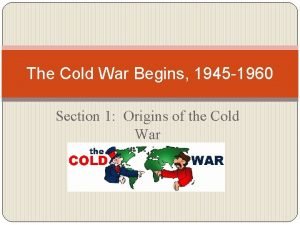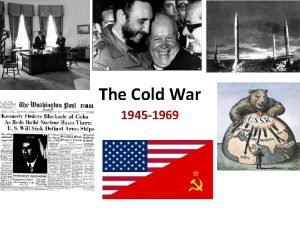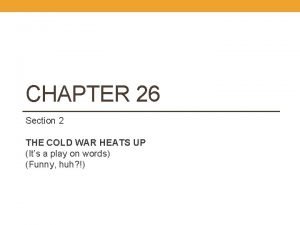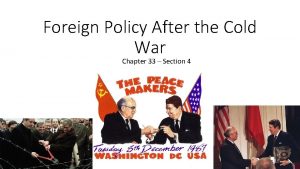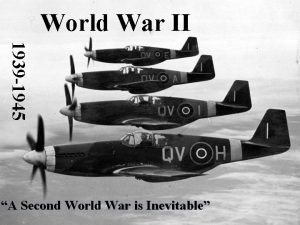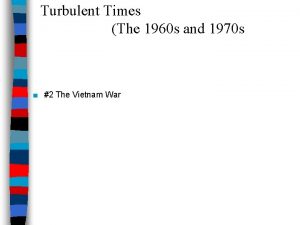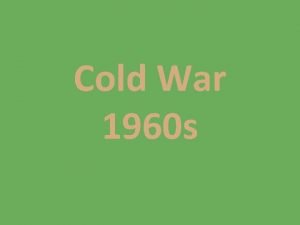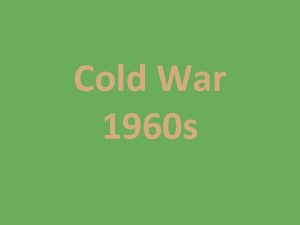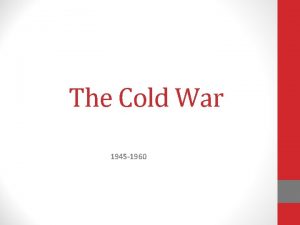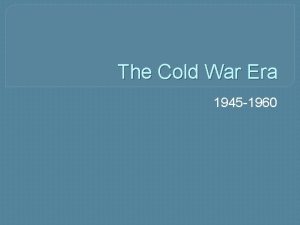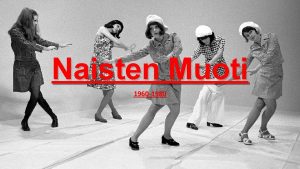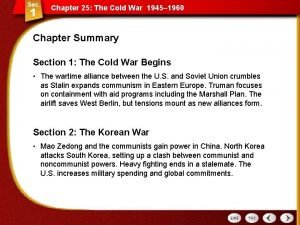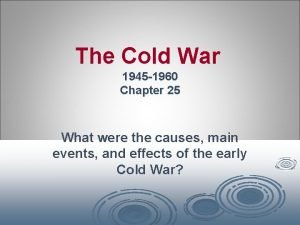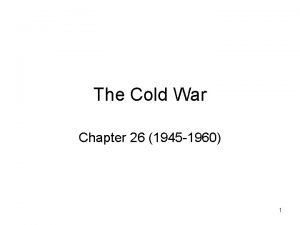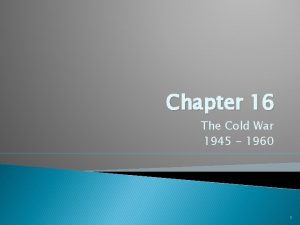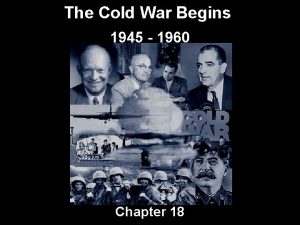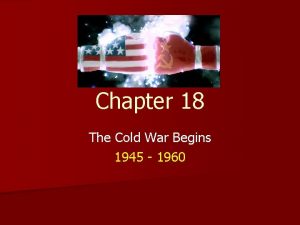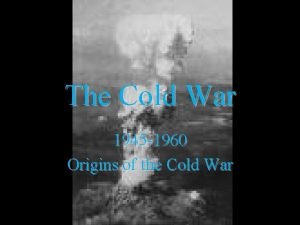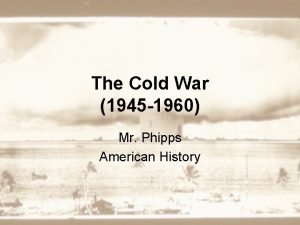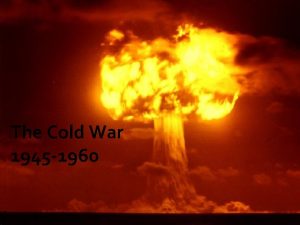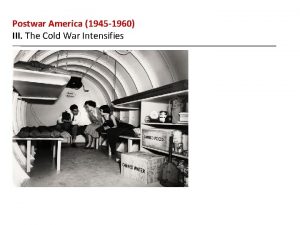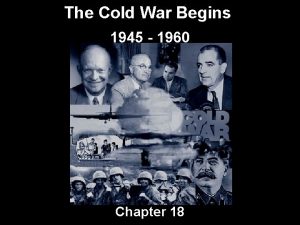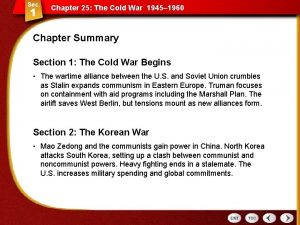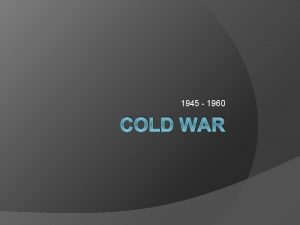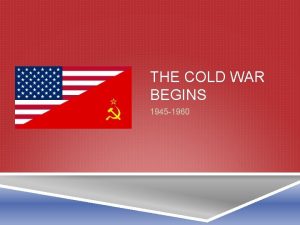The Cold War 1945 1960 Cold War Policy


























- Slides: 26

The Cold War 1945– 1960 Cold War Policy Under President Eisenhower Power. Point by Mr. Hataway Created January 29, 2003 Revised March 10, 2004 Second Revision February 12, 2012

Cold War Policy Under President Eisenhower u Today, I will learn … – u I will learn it by … – u Eisenhower’s plan to reduce world tensions and contain communism. Listening and taking notes using Cornell Notes strategy. I have learned it when I can … – Explain the following: massive retaliation, Sputnik, brinkmanship, NASA, NDA.

Cold War Policy Under President Eisenhower Ø Essential Question: – How were Cold War tensions intensified by the arms race and the space race?

Focus Ø How do you react when you feel threatened? Ø Do you think that those same reactions apply to nations? Explain.

Eisenhower’s Policies Ø Dwight D. Eisenhower, national hero and general who organized the D-Day invasion, was elected president in 1952. Circa 1943

Eisenhower’s Policies Ø Eisenhower believed that the way to win the Cold War was through a strong military and a strong economy. – – conventional war too expensive. atomic weapons necessary.

Discussion Question Ø Why did Eisenhower feel a strong economy would win the Cold War? – – Eisenhower felt that the United States need to show that free enterprise would produce more prosperous society than communism. Economic prosperity would also prevent Communists from gaining support in the United States, protecting the U. S. from subversion.

Eisenhower’s Policies Ø “Massive Retaliation” – – – Policy first proposed by Sec. of State, John F. Dulles. Threatened use of nuclear weapons on any Communist state that tried to gain territory through force. Fueled the arms race.

Eisenhower’s Policies Ø New weapons technology – – – B-52 long range, heavy bomber Intercontinental ballistic missiles Submarines with nuclear missile launchers

B-52 Long Range, Heavy Bomber


USSR and United States Nuclear Weapons Stockpiles 1945 -2005

Eisenhower’s Policies Ø Sputnik (Oct. 4, 1957) – – – Launched by the Soviet Union. first artificial satellite to orbit the earth. Americans felt they were falling behind in missile technology.

Eisenhower’s Policies Ø NASA – – Eisenhower established NASA in response. U. S. launched its own satellite, Explorer I, in January 1958. Explorer I

Eisenhower’s Policies Ø National Defense Education Act (NDEA) – passed in 1958 in response to the launching of Sputnik by the Soviet Union.

Eisenhower’s Policies Ø Education priorities were focused on math and science.

Discussion Question Ø How did the Soviet launch of Sputnik affect American public opinion and policy? – – Americans were shocked and frightened that the Soviet Union was technological ahead of the United States in the arms race in and in the space race. This caused U. S. public opinion to favor a large military buildup to surpass the Soviet Union.

Brinksmanship in Action Ø Brinksmanship: Eisenhower’s willingness to threaten nuclear war to maintain peace.

Brinksmanship in Action Ø Ending the Korean War (1953) – Korean War ended with the signing of armistice only after Eisenhower threatened to use nuclear weapons.

Brinksmanship in Action Ø Taiwan Crisis (1954) – – In 1954, China threatened to take over two of the islands from the Nationalists. Eisenhower threatened use of nukes, and China retreated.

Brinksmanship in Action Ø Suez Crisis (1956) – – – Eisenhower offered to help finance construction of a dam on the Nile River in Egypt. Congress forced the U. S. to withdraw the offer. Egyptians took control of the Suez Canal to use its profits to pay for the dam.

Brinksmanship in Action Ø Suez Crisis (1956) – – – British and French troops invade the Suez Canal. Soviets threatened attacks on Britain and France. USA pressured Britain and France to remove troops.

Soviet-American Tensions Stalin died in 1953. Ø Nikita Khrushchev became new premier. Ø – – Khrushchev suggested peaceful competition might be possible. Khrushchev visited US & Nixon visited USSR (1959) At the UN in 1960, Khrushchev caused uproar when he famously used his shoe to bang on the desk after the Philippine delegate accused the USSR of imperialism in Eastern Europe.

Soviet-American Tensions Ø Eisenhower and Khrushchev Summit Meeting in Paris 1960 – – Soviets shot down American spy plane piloted by Francis Gary Powers. Khrushchev stops summit.

Discussion Question Ø What happened when the Soviet Union shot down an American U-2 spy plane? – – – Ø Eisenhower first claimed it was a weather plane that had strayed off course. Khrushchev dramatically produced the pilot. After Eisenhower refused to apologize, Khrushchev stopped the summit in Paris. How might the Cold War have progressed if the U-2 incident had never occurred?

 The cold war begins 1945-1960
The cold war begins 1945-1960 The cold war heats up: 1945 - 1969
The cold war heats up: 1945 - 1969 Chapter 26 section 2 the cold war heats up answer key
Chapter 26 section 2 the cold war heats up answer key Welcome 1 unit 10 lesson 1
Welcome 1 unit 10 lesson 1 Chapter 33 section 4 foreign policy after the cold war
Chapter 33 section 4 foreign policy after the cold war 1945 world war ii
1945 world war ii 1945 world war
1945 world war Cold war sides
Cold war sides Vietnam war 1960
Vietnam war 1960 Tư thế worms-breton
Tư thế worms-breton đại từ thay thế
đại từ thay thế Quá trình desamine hóa có thể tạo ra
Quá trình desamine hóa có thể tạo ra Công của trọng lực
Công của trọng lực Thế nào là mạng điện lắp đặt kiểu nổi
Thế nào là mạng điện lắp đặt kiểu nổi Các loại đột biến cấu trúc nhiễm sắc thể
Các loại đột biến cấu trúc nhiễm sắc thể Bổ thể
Bổ thể Vẽ hình chiếu đứng bằng cạnh của vật thể
Vẽ hình chiếu đứng bằng cạnh của vật thể Phản ứng thế ankan
Phản ứng thế ankan Các môn thể thao bắt đầu bằng tiếng chạy
Các môn thể thao bắt đầu bằng tiếng chạy Thiếu nhi thế giới liên hoan
Thiếu nhi thế giới liên hoan Sự nuôi và dạy con của hổ
Sự nuôi và dạy con của hổ điện thế nghỉ
điện thế nghỉ Một số thể thơ truyền thống
Một số thể thơ truyền thống Nguyên nhân của sự mỏi cơ sinh 8
Nguyên nhân của sự mỏi cơ sinh 8 Trời xanh đây là của chúng ta thể thơ
Trời xanh đây là của chúng ta thể thơ Số.nguyên tố
Số.nguyên tố Tỉ lệ cơ thể trẻ em
Tỉ lệ cơ thể trẻ em
